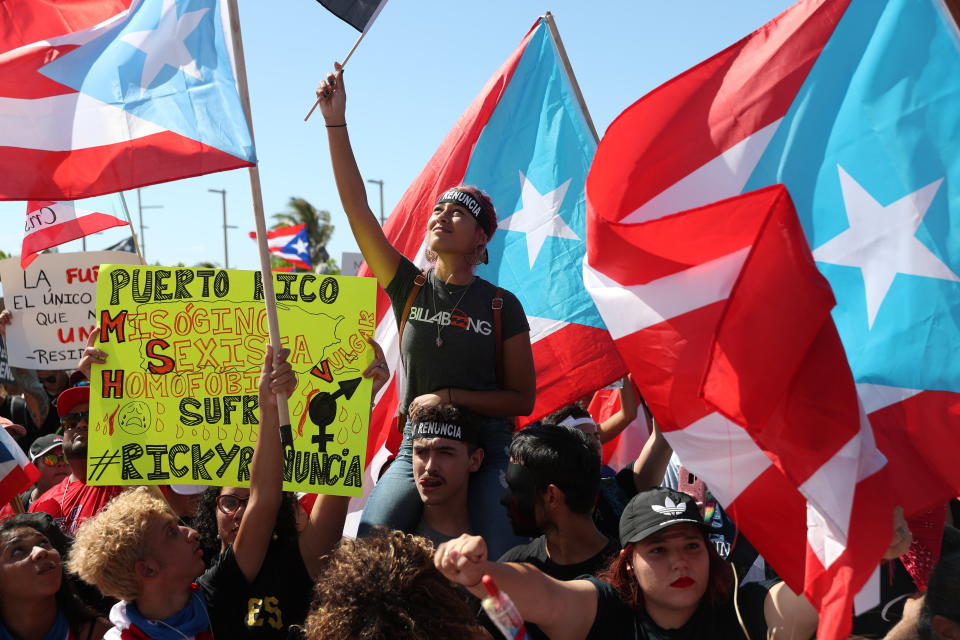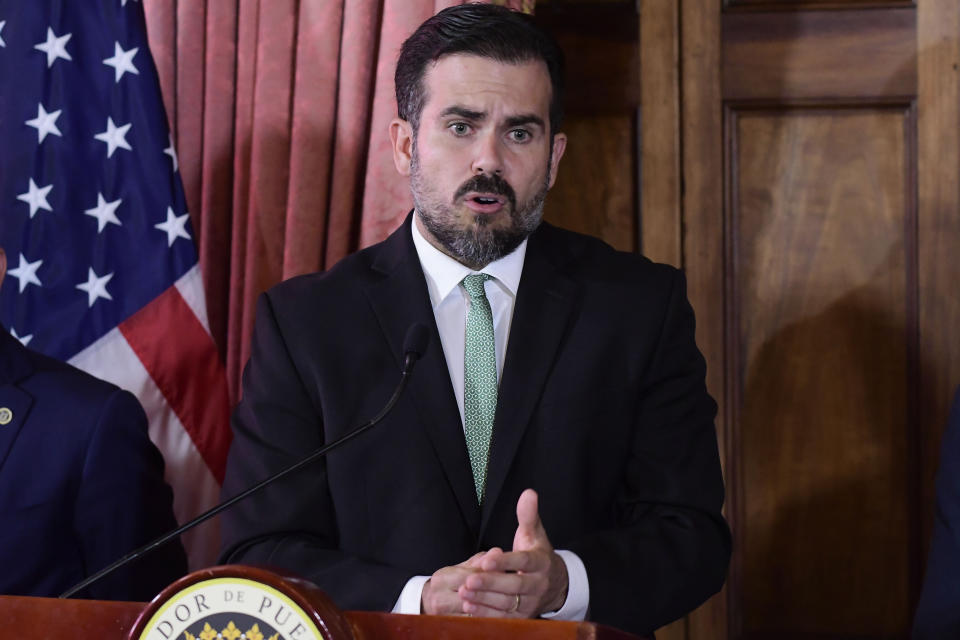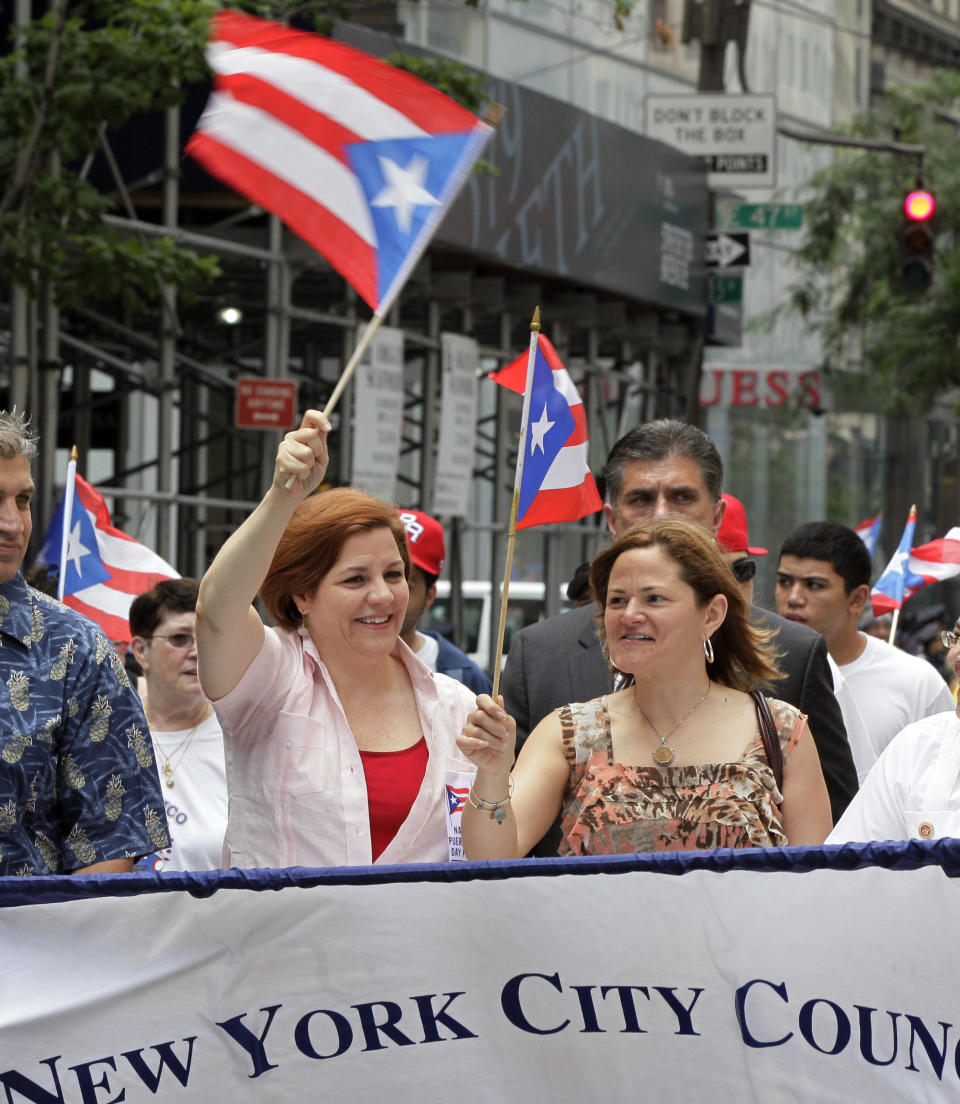As New Political Scandals Engulf Puerto Rico, How Much More Can The Island Take?
Puerto Rico plunged into a fresh round of political turmoil this past week as scandal engulfed Gov. Ricardo Rosselló’s administration and sent thousands into the streets of San Juan to demand his resignation.
FBI agents arrested two former top officials ― Julia Keleher, who served as Puerto Rico’s secretary of education until April, and Ángela Ávila-Marrero, who headed the island’s Health Insurance Administration until last month ― on July 10 for allegedly directing lucrative government contracts to unqualified, politically connected contractors.
One day later, an anonymous source leaked the governor’s private chats on the encrypted messaging app Telegram to local media outlets. On Saturday, Puerto Rico’s Center for Investigative Journalism published 889 pages of the logs, showing Rosselló and his Cabinet officials making crass, misogynistic and homophobic remarks. Secretary of State Luis Rivera Marín and Chief Financial Officer Christian Sobrino resigned following the release.
By Monday night, protests turned chaotic when police fired tear gas into the dense crowd that filled the cobblestone corridors outside the governor’s Old San Juan mansion. The demonstrators’ numbers swelled, by one estimate, to 100,000 by Wednesday night, as a new analysis of the chat logs laid bare what the investigative outlet called a “multimillion-dollar corruption network” spanning “many public agencies.”
Rosselló has vowed to remain in office, but many are wondering how much more chaos Puerto Rico can take.
The island, home to 3.2 million Americans, was an early bellwether for the economic struggles that now undergird much of the political strife across the developed world. In the late 1990s, then-President Bill Clinton phased out corporate tax breaks that had drawn pharmaceutical and other manufacturers to the island. The only exemption kept in place was tax-free municipal bonds that, as a territory of the United States, offered lucrative and dependable returns.

When those companies left the island, so too went jobs and the tax base. So officials issued more and more debt to pay for the basic upkeep of schools, roads and law enforcement. The island was considered the “belle of the bond market” until 2013, when the Wall Street firms that owned the debt began demanding repayment. Coupled with ballooning pension obligations, the Puerto Rican government couldn’t keep up with payments on what had soared to an 11-figure deficit.
Financial giants including Goldman Sachs, Citigroup and Barclays Capital stepped and restructured the debt to include interest rates of 785%, roughly doubling the deficit while charging an additional $1.6 billion in fees. By 2016, Puerto Rico was suffocating with roughly $74 billion in debt and $49 billion in pension obligations. And creditors wanted their money back.
But, as a territory, the island couldn’t declare bankruptcy in the way a state or mainland U.S. city, such as Detroit, could. Instead, Congress passed the Puerto Rico Oversight, Management, and Economic Stability Act ― known by its acronym, Promesa, which is Spanish for “promise.” Once President Barack Obama signed it in mid-2016, the law put in place an unelected financial oversight board to manage the territory’s spending. To make payments, the board, known to Puerto Ricans as la junta, imposed strict austerity measures, closing schools, slashing retirees’ pensions and halting long-overdue investments in shoddy, aging infrastructure.
Then came the two powerful hurricanes of 2017, which wrecked up to 90% of the homes in some communities, caused $90 billion in damages and completely destroyed the island’s electrical grid.
The second storm, the Category 5 Hurricane Maria, became the deadliest natural disaster in modern American history, with a death toll roughly twice that 2005’s Hurricane Katrina in Louisiana. The storm dumped roughly 2 feet of rain on the island in just two hours, flooding coastal neighborhoods and destroying property. But the vast majority of the 3,057 recorded killed in the official death toll died in the days and weeks that followed, when impassable roads, supply shortages and a lack of electricity cut off access to basic health care and clean water. A Harvard University study pegged the actual death total much higher, at 4,645. Almost 700 diabetics died without refrigerated insulin alone.
It took 11 months to restore power to the island, notching the second-longest blackout in world history. The reconstruction process attracted a new kind of vulture.

Less than a month after the storm, the state-owned Puerto Rican Electric Power Authority granted a $300 million contract to Whitefish Energy, a two-person firm based in Whitefish, Montana, to rebuild the mangled power lines. Soon after the company’s linemen arrived on the island, the contract drew scrutiny. Whitefish’s linemen, flown in from the mainland, made $319 an hour, roughly 17 times the average salary a Puerto Rican counterpart earned. The company had no experience working in the region but had ties to then-Interior Secretary Ryan Zinke and a top donor to President Donald Trump. By the end of the month, PREPA canceled the contract.
That same October, the utility inked a $200 million deal with Cobra Acquisitions LLC, a newly formed subsidiary of Oklahoma-based fossil-fuel giant Mammoth Energy Services, to rebuild power lines into San Juan. The contract lacked much of the Whitefish deal’s most egregious fine print. But, given Mammoth’s minimal experience in disaster relief, the deal appeared to be an early sign the fossil-fuel industry was securing its grip on PREPA, The Intercept reported at the time. The utility, then $9 billion in debt, had already paid out $1 billion a year to off-island oil and gas firms.
Projections show that the island’s abundant solar and wind potential light PREPA’s path to financial stability, yet Republican lawmakers in Washington made it clear that gas should play a key role in the rebuilt electrical grid. Despite signing a law in April mandating 100% renewable electricity by 2050, the Rosselló administration issued a request for qualifications to build a new gas import terminal on the island last Friday.
The scramble for Puerto Rico illustrates the political phenomenon author Naomi Klein dubbed the “shock doctrine,” wherein profiteers swoop in after a disaster to exploit public goods. Crushed by debt and devastated by storms, Puerto Rico charged ahead on efforts to privatize public services. That has included selling off parts of PREPA to investors and diverting public school funding to privately run charter schools.
In March 2018, Keleher, then the education secretary, proposed a plan to start introducing charter schools on the island. The proposal came as the government vowed to close an additional 265 public schools to meet spending cuts the financial oversight board required. Teachers unions led fiery protests against both plans last summer.
That outrage, still on simmer when the latest scandals broke this month, is now back to a boil.
“This has been accumulating for a long time,” said Margaret Power, an expert in Puerto Rican history at the Illinois Institute of Technology. “Many, many, many Puerto Ricans feel their country is up for grabs.”
The indictments released last week accused Keleher of steering business to a firm owned by her assistant’s sister, even after the company was found to be unqualified for the job. The former Cabinet secretary also allegedly directed work to the accounting firm BDO Puerto Rico, where an employee she collaborated with received an undisclosed 10% commission on each government contract he won.
“People are pissed off that they’re the ones paying the price while private companies are collecting 10% for doing nothing,” Venator-Santiago said. “This is all the failure of austerity and privatization. This is the failure of trickle-down economics.”
Puerto Ricans have hit a breaking point before. For decades, the U.S. Navy used Vieques, an island off the coast of Puerto Rico’s mainland, as target practice, firing depleted-uranium shells at an 8-mile island home to roughly 9,300 people. The Viequenses suffered the resulting pollution, with a cancer rate 30% higher than the rest of Puerto Rico. But, in 1999, a stray munition killed a local resident in a bombing run, sparking a protest movement known as “the struggle” that eventually forced the Navy to close its base.
“The response we see from many Puerto Ricans counters the still-popular narrative of Puerto Ricans as docile colonial subjects,” said Catalina de Onís, an assistant professor of civic communication at Willamette University in Oregon. “Much like with the ousting of the U.S. Navy in Vieques, which involved years of struggle and perseverance, many are mobilizing to craft an alternative future that rejects domination, corruption and injustice.”
Even if Rosselló remains, he may lose next year if he decides to follow through on his plan to run for reelection. And the years-long fight against austerity could soon yield some limited relief. In June, the financial oversight board agreed to soften a potential cut to pensions, keeping 61% of retirees whole, up from 25%. As of this week, federal negotiators were nearing an agreement to lock in the deal, which would force creditors to take a hit on returns, according to The New York Times. But the financiers are likely to sue, arguing that prioritizing pension obligations to retirees over payments to bondholders violates the territory’s 1952 constitution.
But that fight may prove a secondary concern for most Puerto Ricans. A new hurricane season began last month and is expected to hit its peak in the next two months.
“We don’t know, considering that Whitefish and Cobra were not qualified or prepared to work on the electrical system here, whether that’s good enough to hold up against another strong hurricane,” said Ruth Santiago, a lawyer who works with environmental groups and lives in Salinas, on Puerto Rico’s south coast. “With the whole way he’s operated since the storm, the governor should resign.”
Love HuffPost? Become a founding member of HuffPost Plus today.
Related Coverage
An Ancient Ceiba Tree Blooms Once Again After Puerto Rico's Devastating Storms
On Puerto Rico’s 'Forgotten Island,' Tesla's Busted Solar Panels Tell A Cautionary Tale
Puerto Rico Is The Best Argument For The Green New Deal
Also on HuffPost
A Majority Didn't Support Statehood

Luis Fortuño's Gone

Puerto Ricans Are Already Citizens

Congress Isn't Interested

This article originally appeared on HuffPost.

